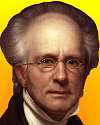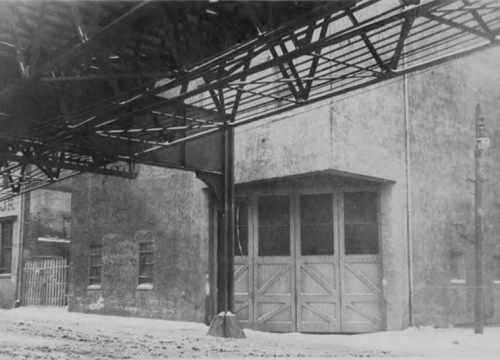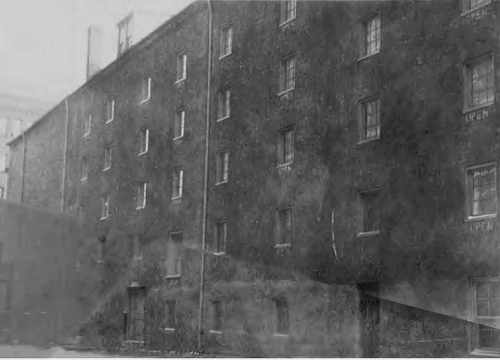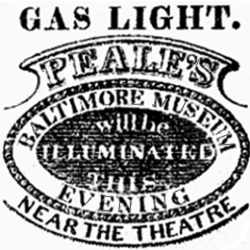 (source)
(source)
|
Rembrandt Peale
(22 Feb 1778 - 3 Oct 1860)
American artist and naturalist , son of Charles Willson Peale, who like his father was a portrait painter and naturalist who popularized the mastodon with a travelling exhibit.
|
The Gas Light Company of Baltimore
from History of Baltimore City and County (1881)
[p.500] The Gas-light Company of Baltimore.—The subject of lighting the streets of Baltimore Town was agitated as early as 1773, when a correspondent of the Maryland Journal suggested the propriety of lighting the streets by lamps to be erected by the householders, a lamp to be placed in front of every sixth house. The cost to each householder was estimated at tenpence per month. The first public lamp that was ever placed in position in Baltimore was suspended in the centre of the street at the intersection of Baltimore and Howard Streets. It could be seen from four directions, and was meant to guide early market-men to the market-house. Shortly after this, however, the suggestions of the correspondent referred to were adopted, and until 1817 the streets were lighted by oil-lamps. In the mean time several efforts were made by scientific men to introduce an improved light. In 1802 much attention was attracted to what was termed “a philosophical exhibition” by Benjamin Henfrey, who proposed to the mayor and City Council of Baltimore “to substitute for the street-lamps one or more Light Houses, to be lighted by means of a certain inflammable gas, with reflectors for increasing and extending the rays of light,” but the practicability of the scheme was not demonstrated satisfactorily, and it failed to receive the encouragement and support of the municipal authorities. Mr. Henfrey then attempted to secure its adoption by private citizens, and gave exhibitions of its capacity both for lighting and warming rooms, and proposed for the modest sum of five dollars to give the right to any person to use his discovery for lighting and warming rooms for seven years, but failed in this effort also. In 1802, Mr. Henfrey succeeded in lighting Richmond, Va., with gas, before it had ever been successfully used elsewhere.1
In 1816, Rembrandt Peale, the proprietor of the Baltimore Museum (old City Hall), gave exhibitions in his saloon of paintings, of the manner of lighting houses by means of “carburetted hydrogen gas,” as discovered by Dr. Benjamin Kugler, of Philadelphia. Mr. Peale charged a small sum for admission to see the new light, and it suggested to him and others the availability of gas for general use, and especially as a substitute for oil in the street-lamps. The use and combination of gases had been understood by science during the seventeenth century, but, with the single exception of Richmond, Va., gas had never been availed of as a light for cities, except to a limited extent in London. A company was accordingly formed, entitled “The Gas-light Company of Baltimore,” composed of Rembrandt Peale, Wm. Lorman, James Mosher, Robert Carey Long, Wm. Gwynn, and others, by whom a proposition was made to the mayor and City Council to light the streets of Baltimore with gas. This proposition was submitted June 13, 1816, at an extra session called by the mayor for the purpose. A committee of three members from each Branch was appointed to examine the apparatus erected by Mr. Peale for the manufacture of the gas, and to make all necessary inquiries as to the manner in which it was intended to light the streets. The joint committee reported favorably, and on the 17th of June an ordinance was passed authorizing “The Gas-light Company of Baltimore” to lay or cause to be laid along and under the streets, squares, lanes, and alleys of the city, paved or unpaved, such and so many pipes as may be necessary to convey the gas from their manufactory or manufactories, which they were also by the ordinance authorized to establish and carry on within the city.
“The Gas-light Company of Baltimore” was chartered by the Legislature of the State by an act passed Feb. 5, 1817, with the original members of the [p.501] company as incorporators. The act of incorporation, declaring the manner in which the capital stock of the company should be distributed, set apart one hundred shares to be assigned to Rembrandt Peale over and above his proportion as a member of the company, as a compensation in full for transferring to the Gas-light Company of Baltimore the patent right assigned to him by Dr. Benjamin Kugler, of Philadelphia. The contract was made with the city, and the gas-works were located at the corner of North and Saratoga Streets. The company got fairly under way in 1820, its first president being William Lorman. The first public building lighted by gas was the old “Mud” or Belvidere Theatre, at the northwest corner of North and Saratoga Streets. The first private building in Baltimore lighted by gas was that of the late Jacob I. Cohen, on North Charles Street; the second that of the late Hugh Birckhead, on the same street. To the city of Baltimore belongs the honor of first adopting gas for street and general use, and the Baltimore company was the first anywhere organized for its manufacture. The first gas-lamp erected and lighted on the streets of Baltimore was on the corner of Market and Lemon Streets. This lamp was lighted for the first time Feb. 7, 1817, and it is stated by the newspapers of those days “that the effect produced was highly gratifying to those who had an opportunity of witnessing it, among whom were several members of the Legislature of the State.” Feb. 16, 1818, only twenty-eight lamps were lighted with gas. From that time the consumption of gas steadily increased, until, instead of three original takers in 1820, there were, in 1870, 15,301 consumers of gas in Baltimore. When Gen. Columbus O'Donnell was elected president and took charge of its affairs in 1831, the whole amount of capital paid in amounted to $250,000, and there was a floating debt of $195,000. Two years later $300,000 were added to the capital, making the entire amount paid in $550,000. The original capital was nearly all exhausted in experiments and by the use of unsuitable pipes, etc. It became necessary to procure additional funds to sustain and carry on the work, and to canvass the city for new subscribers, many of the old stockholders refusing to subscribe for additional stock. The directors were also forced to resort to loans based on their individual credit. The scale of charges was originally regulated by the number of burners used, but in 1830 the present system of measuring the gas was introduced.


Original Davis Street Works, Gas-light Company of Baltimore, as they were in c.1927 at Saratoga and North Streets (now Guilford Ave.). Front (left) and Side views.
In 1846 the company had only four gasometers, capable of holding one hundred and forty thousand cubic feet of gas, and in that year they erected a new one at the corner of Franklin and Little Davis Street. It was not until 1847 that gas was employed in the city markets. In that year gas-fixtures were put into the new Belair Market-house, and then in Centre or Marsh Market, and soon afterwards in nearly all the other markets of the city, except the Lexington Market, where gas was not introduced until 1851.
In 1865 the Baltimore Gas-light Company purchased from the Canton Company the large tract of land between the old Kendall race-course and the harbor, north of the old candle-factory, with a front of over four hundred feet, and nearly as much in depth, for the sum of thirty-five thousand dollars, and erected upon it a large gasometer, for the purpose of supplying the eastern section of the city.
On the 31st of November, 1870, the franchises and property of the Baltimore Gas-light Company were sold to capitalists of Brooklyn, N. Y., for three million dollars. The real estate acquired by the purchase on the part of the Brooklyn capitalists consisted of between sixty-five and seventy acres of land in South Baltimore, near Spring Gardens, valued, with the improvements thereon, at seven hundred thousand dollars. The improvements consisted of all the necessary apparatus for the manufacture of gas, a number of small dwellings occupied by the employés of the company, the building occupied for office purposes, fronting twenty-four feet on South Street, with a depth of two hundred feet to Holliday Street, valued at seventy thousand dollars, about five acres of land at Canton, with a water-front of four hundred feet, twelve brick dwellings, and a large gasometer; and the extensive property on North Holliday Street. The works at Spring Gardens, South Baltimore, are said to be the most complete in the United States. The formal transfer and the last payment were made on the 26th of January, 1871. Gen. Columbus O'Donnell served as the president of the company for nearly forty years. After the sale and transfer of the franchises and property of the company to the Brooklyn capitalists the company was reorganized, with S. L. Husted as president, and C. Oliver O'Donnell as vice-president.
“The Gas-light Company of Baltimore,” “The People's,” and “The Consumers' Mutual Gas-light Company” on July 1, 1880, consolidated. The capital stock was made six millions of dollars, divided into sixty thousand shares of the par value of one hundred dollars each. Provision was made for the execution to trustees of a mortgage to secure the payment of three million six hundred thousand dollars of the bonds of the company or such parts thereof in excess of two million six hundred thousand dollars as it may be deemed advisable to issue. The first board of directors of the new company was as follows: William Sinclair, Lyman L. Husted, Arthur W. Benson, Austin Jenkins, William F. Burns, William H. Graham, Walter B. Brooks, William W. Spence, John W. Hall, James A. Gary, Henry James, and Bernard Carter. The presidents at this time were William Sinclair, of the Gas-light Company; William F. Burns, of the People's; and John W. Hall, of the Consumers' Company. The new company, under the name of the “Consolidated Gas Company of Baltimore City,” began business on the same day at the office of the old company on South Street.
“Macon W. Johnson.”
[Electrical lighting came to Baltimore when The Brush Electric Light Company of Baltimore was incorporated on April 16, 1881.]
[An earlier book by the same author, The Chronicles of Baltimore (1874), has a brief version of the above information, but with a few differences. See the link below.]
- Science Quotes by Rembrandt Peale.
- 22 Feb - short biography, births, deaths and events on date of Peale's birth.
- The Gas Light Company of Baltimore - brief description from The Chronicles of Baltimore (1874).
- Booklist for Rembrandt Peale.





